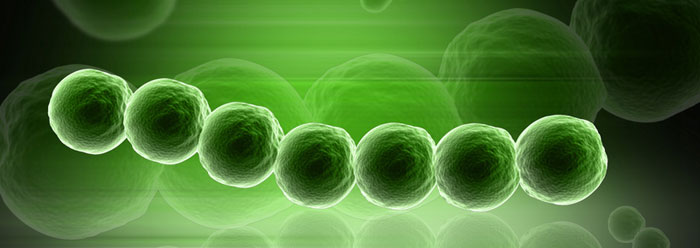Certain classes of antibiotics can no longer eliminate a resistant strain of common skin-covering bacteria. This new strain can now cause infections as it grows amidst the non-resistant strains that are killed by the antibiotic. Although some observers claim this represents upward evolutionary development, amazing results from an in-depth analysis suggest that these bacteria were designed to make such changes and that evolution had nothing to do with it.
All cells must make proteins, and for this they use protein-building apparatuses called ribosomes. A ribosome is very large compared to most biomolecules and consists of modular portions of proteins and nucleic acids. In normal, non-resistant populations of the bacteria under investigation, an enzyme called RlmN readies the ribosome by adding a methyl group…in essence, a methane molecule…to carbon number two on the ribosome's 2503rd nucleic acid. The antibiotic called methicillin kills these bacteria by clogging their ribosomes at exactly that spot.
The resistant bacterial strain has the enzyme Cfr instead of RlmN. This very similar enzyme readies its "substrate," or the ribosome, by adding a methyl group to carbon number eight on the ribosome's 2503rd nucleic acid. Cfr does almost the same job as RlmN, and that tiny difference is just enough to enable its bacterial strain to survive in a sea of methicillin poison…although this probably decreases the overall efficiency of the ribosome in the resistant bacteria.
Did RlmN enzyme in this bacteria evolve by random mutations and natural selection to become Cfr, or did this change arise through designed means?
Biochemists led by Penn State's Squire Booker carefully analyzed these two enzymes. Their study, published in Science Express on April 28, 2011, stated that the enzymes' structures "have important implications for the evolution of Cfr, which confers antibiotic resistance."1 But the same authors admitted that the essential Cfr enzyme looks like it was produced by some kind of designed adaptability. And this would mean that it did not evolve by chance.
RlmN and Cfr both use four sulfur atoms linked to four iron atoms all packed together like the corners of a tiny box in order to perform their precise chemical addition of a methyl group onto the ribosome. The study authors wrote that this is "a housekeeping modification important" in properly building new proteins.1 Without this exact arrangement of atoms in what is called the "active site" of these enzymes, the ribosome would not build proteins and the cell would die.
In the researchers' scenario, RlmN was supposed to have "evolved" into Cfr. But the actual changes from RlmN to Cfr involved losses of information! RlmN found in what is presumably the original, wild bacterial population has some flexible regions that Cfr does not have. It looks as though this RlmN lost these regions to become the similar Cfr.
That's no help to big-picture evolution, which is faced with accounting for the origin of all of life's information…like the precise spatial and "electrostatic surface potential" distributions in these vital enzymes…without any intelligent source.1 To demonstrate evolution, organisms would need to show a continual gain of new information. However, changes due to loss of information typify examples of bacterial antibiotic resistance, as well as bacteria's "learned" ability to metabolize new substances such as nylon.2
The study's authors made a stunning suggestion in their final sentence:
If loss of these motifs [flexible regions] allows Cfr to modify a different site [carbon number eight], their distance from the active site is noteworthy and leaves open the possibility that the enzyme/substrate complex uses an extended interaction surface to fine tune control of substrate [ribosome] binding and site selectivity.1
In other words, nothing was lost from the core of the enzyme, where the critical chemistry takes place, after changes had occurred elsewhere. Even very tiny changes to the enzyme's active site would have broken the enzyme and irreparably damaged the bacteria. Instead, only the flexible protein regions were removed…just the modifications that one would expect from a machine designed to fine-tune its operational effectiveness without completely destroying its function. The chances of just the right kinds of adjustments being made randomly to this enzyme are very tiny, and therefore point directly to mindful purpose.3
It looks as though the RlmN enzyme was created with adaptive programming to "fine tune" its application, yet without disrupting its core function. Thus, adaptive programming, not evolution, is responsible for the ability of this strain of bacteria to survive in methicillin. If verified by further research, the origin of this spectacular adaptive design would only be explainable by an ingenious Creator.
References
- Boal, A. K. et al. Structural Basis for Methyl Transfer by a Radical SAM Enzyme. Science Express. Posted on sciencemag.org April 28, 2011, accessed April 28, 2011.
- Specifically, some enzymes lose a degree of substrate specificity. While this can result in that enzyme's ability to catalyze more reactions, the mutated enzyme loses efficiency of its original function. And none of this helps in any way to explain how the enzyme got there to begin with. For more specifics, see: Anderson, K. L. and G. Purdom. 2008. A Creationist Perspective of Beneficial Mutations in Bacteria. In Proceedings of the Sixth International Conference on Creationism. Snelling, A. A., ed. Pittsburgh, PA: Creation Science Fellowship and Dallas, TX: Institute for Creation Research, 73-86.
- For a general review of the reasons why the probability of new and useful protein folds occurring through Darwinian evolution is impossibly small, see Axe, D. D. 2010. The Case Against a Darwinian Origin of Protein Folds. Bio-Complexity. 1: 1-12.
* Mr. Thomas is Science Writer at the Institute for Creation Research.
Article posted on May 10, 2011.
























